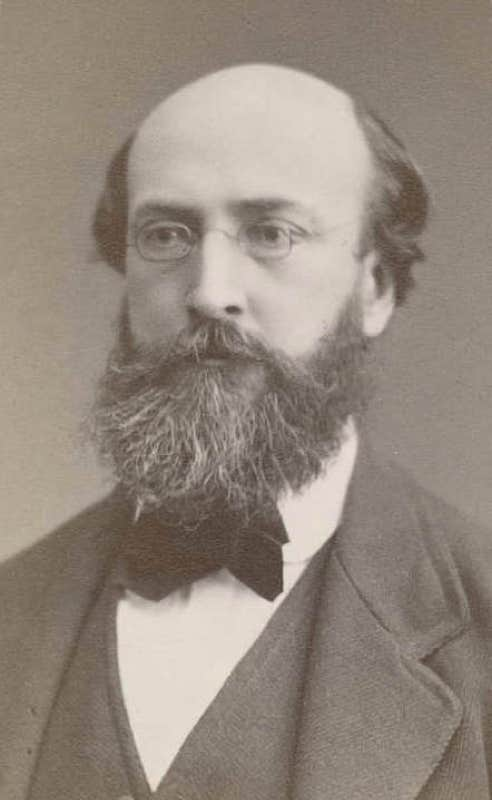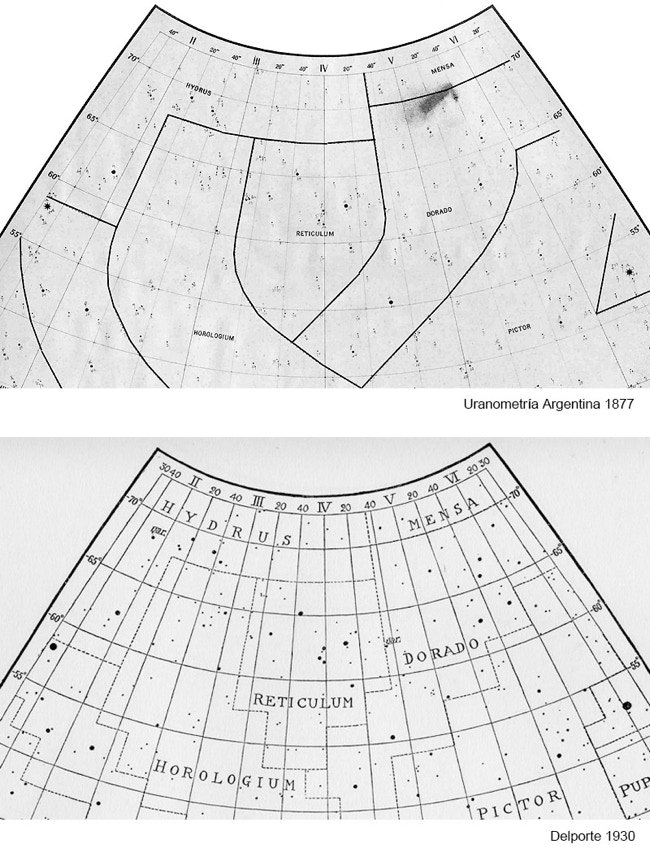Benjamin Apthorp Gould and the
Uranometria Argentina
Benjamin Apthorp Gould in 1877, the year that the Uranometria Argentina atlas was published. (Courtesy Special Collections, University Library, University of California Santa Cruz. Lick Observatory Records)
THE American astronomer Benjamin Apthorp Gould, Jr (1824–96) played an influential role in the modern history of the constellations, although his contributions have become largely forgotten. Gould was author of Uranometria Argentina, a catalogue of the southern hemisphere naked-eye stars which contains much incidental information about constellation history and stellar nomenclature which he helped reform. The associated star charts initiated the procedure of outlining constellation boundaries along lines of right ascension and declination, in place of the meandering freehand lines that had been used hitherto. In modified form, Gould’s system became the basis of the modern constellation boundaries that were published by the IAU in 1930.
From Germany to Argentina
Gould has the distinction of being the first American to receive a PhD in astronomy, which he obtained in Göttingen, Germany, under the tutelage of the great German celestial mathematician Carl Friedrich Gauss. The influence of German astronomers remained apparent throughout his working life.
Returning to the US, Gould distinguished himself in the field of positional astronomy (known as astrometry). To promote the publication of American astronomical research, in 1849 he founded the Astronomical Journal as a US counterpart to the great European journal of the time, Astronomische Nachrichten. It remains one of the pre-eminent astronomical research journals in the world.
Gould recognized that the cataloguing of the southern half of the sky lagged far behind that of the north. During the 1860s he began to consider undertaking a new southern sky survey himself with the intention of extending the German Bonner Durchmusterung to the south celestial pole. He approached the Argentine envoy to Washington, Domingo F. Sarmiento, about the possibility of making his observations from that country. The Argentine government readily agreed, and when Sarmiento became the country’s president in 1868 they also offered to build a permanent observatory themselves. The Argentine National Observatory, now the Astronomical Observatory of Córdoba, was officially founded in 1871 by Sarmiento, with Gould as its director.
Uranometria Argentina
Gould had ordered instruments and building materials from Europe and the US, but they were slow in arriving. Lacking telescopes, he decided to fill the time by making a naked-eye survey of the southern sky modelled on F. W. A. Argelander’s Uranometria Nova, a catalogue and atlas of the northern naked-eye stars that had been published in Germany in 1843.
Gould was too short-sighted to participate in the observations himself, but instead relied on four young assistants who had joined him in Córdoba from the US: John Macon Thome (1843–1908), William Morris Davis (1850–1934), Clarence Lockwood Hathaway (1846–1930), and Miles Rock (1840–1901). Observations began at the end of 1870, even before the official founding of the observatory, and continued for over three years while the observatory took shape around them.
Starting with hand-drawn charts of stars down to fourth magnitude, they gradually filled in the fainter stars to build up a complete coverage of the sky south of declination +10°, i.e. within 100° of the south celestial pole. In the exceptionally clear air at the observatory site, the observers found that on the best nights they could see stars down to what they judged to be mag. 7.0, and this became their limiting magnitude. (Modern photometry has, however, suggested that the true limit was closer to 6.5.) Brightnesses were estimated to the nearest tenth of a magnitude, and the results regularly cross-checked between observers, in some cases revealing new variable stars. As a final check, all the stars were observed with the observatory’s newly installed meridian circle to confirm their identification and position.
Constellation boundaries – Gould’s innovation
For the next step in the project, the plotting of the atlas, the team was joined by Albert K. Mansfield, an engineer rather than an astronomer. It was at this stage that Gould ran into the problem that beset every celestial cartographer of the time: the lack of any generally accepted list of constellations or certified boundaries for them. What was needed, he realized, were perimeter lines that were defined scientifically and would be consistent from map to map, and era to era, instead of the imprecise lines that wandered uncertainly around constellations on existing charts. Even the master astrometrist Argelander had not resolved this problem.
Taking his cue from an idea floated some 30 years earlier by John Herschel, Gould drew up constellation boundaries based on lines of right ascension and declination for the year 1875, which was the epoch for his star positions. These were supplemented where necessary by ‘regular curves as near as may be to great circles’, as he put it. Hence there could no longer be any ambiguity as to which constellation a particular star belonged, at least in the southern half of the sky.
Half a century later, when the Belgian astronomer Eugène Delporte (1882–1955) came to draw up official boundaries for the entire sky on behalf of the International Astronomical Union, he followed Gould’s principle, although with the arcs replaced by orthogonal lines of right ascension and declination.
Benjamin Gould’s new constellation boundaries in the Uranometria Argentina (top) incorporated arcs as well as straight lines. For the official IAU boundaries of 1930, the arcs were abolished in favour of strict orthogonals of right ascension and declination. (Córdoba Astronomical Observatory Library, courtesy Santiago Paolantonio)
As for the constellations themselves, Gould adopted only those that were in the catalogues of Ptolemy, Hevelius, and Lacaille, including Lacaille’s division of Argo Navis into Carina, Puppis, and Vela. He followed the lead of Francis Baily in his British Association Catalogue of 1845 by reducing Lacaille’s double-barrelled names to one word. As with Baily, none of Bode or Lalande’s inventions were accepted, spelling the end for figures such as Machina Electrica and Globus Aerostaticus. Unlike Baily, though, Gould reinstated Lacaille’s Pyxis, which Baily had changed to Malus, and Hevelius’s Scutum, which Baily had dropped altogether.
The Uranographia Argentina atlas was published in 1877, containing 13 charts in stereographic projection plus a 14th index chart, covering the sky from the south celestial pole to +12.5°. The accompanying catalogue, listing 7,756 stars, followed two years later, as Volume I of the Resultados del Observatorio Nacional Argentino. Among the extensive notes to the catalogue Gould discussed what he referred to as a ‘belt or stream of bright stars [that] appears to girdle the heavens very nearly in a great circle’. This stream of bright stars is now known as Gould’s Belt.
Gould’s Uranometria Argentina catalogue of 1879 was arranged on a constellation-by-constellation basis, starting at the south celestial pole with Octans and spiralling northwards to 10° north of the equator. Positions were given for the year 1875. The numbers in the left-hand column of this catalogue are known as Gould numbers. They are rarely used, but when seen are given a capital G suffix to distinguish them from Flamsteed numbers.
Córdoba Durchmusterung
Gould returned to the United States in 1885 and resumed publication of the Astronomical Journal, which had been suspended on the outbreak of the American Civil War in 1861. He was succeeded as director of the Córdoba Observatory by his long-time assistant John M. Thome, the only one of the original four observers who was left.
The great southern star survey that Gould had originally conceived, the southern equivalent of the Bonner Durchmusterung, finally appeared many years later as the multi-volume Córdoba Durchmusterung (durchmusterung is a German word that means screening or survey). It contained over 600,000 stars of 10th magnitude and brighter from –22° to the south celestial pole, recorded with the observatory’s 12.5-cm telescope by Thome and his assistant Richard Hawley Tucker. The first four volumes, edited by Thome, were published in 1892–1914, while the fifth appeared under Thome’s successor, Charles Dillon Perrine, in 1932. Stars in the Córdoba Durchmusterung catalogue bear CD numbers, which are still used as identifiers today, as are BD numbers for stars in the Bonner Durchmusterung.
© Ian Ridpath. All rights reserved
The Bonner Durchmusterung was a catalogue of 324,198 stars down to 9th magnitude from the north celestial pole to declination 2° south, compiled at Bonn, Germany, by F. W. A. Argelander. It was published in three volumes in 1859–62, with an associated atlas in 1863.


